- Electric vehicle motors offer instant torque delivery and responsive throttle control, providing quick acceleration.
- Regenerative braking allows electric vehicles to capture kinetic energy during deceleration, improving energy efficiency and extending driving range.
- Motor controllers play a crucial role in converting battery energy into motion, regulating speed and torque, and direction for optimal performance.
- Electric motors have fewer moving parts than internal combustion engines, leading to lower maintenance requirements and quieter operation.
Electric vehicles (EVs) have become increasingly prevalent on roads worldwide because they offer a cleaner, more efficient alternative to traditional internal combustion engine (ICE) vehicles.
At the heart of every EV is the electric motor, the critical component that propels a vehicle by converting electrical energy into mechanical energy. This article will explore the basics of electric vehicle motors, their types, how they work, and the advantages they offer over traditional engines.
See also: Don't Force People To Buy Electric Cars - Akio Toyoda
A Quick Introduction To Electric Vehicles
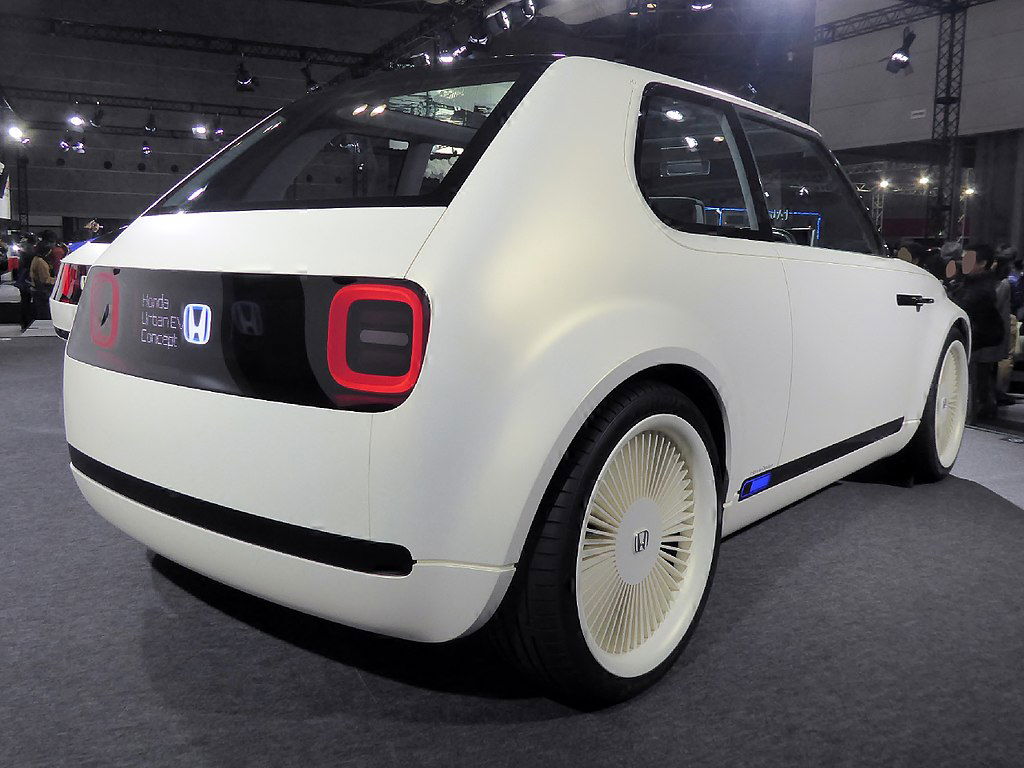
2017 Honda EV Concept - Photo credit: Tokumeigakarinoaoshima via Wikimedia
Electric vehicles (EVs) are revolutionizing the automotive industry with their sustainable and efficient technology. As concerns over climate change and air pollution escalate, EVs have emerged as a compelling solution, offering a cleaner alternative to traditional gasoline-powered vehicles.
With advancements in battery technology and infrastructure, EVs are gaining popularity worldwide, with an increasing number of consumers and governments embracing them.
Beyond reducing greenhouse gas emissions, EVs contribute to improved air quality and reduced dependence on fossil fuels. The growing market for EVs reflects a shift towards sustainable transportation.
Understanding Electric Motors

Photo credit: DoE
An electric motor is fundamentally different from an ICE because it does not rely on burning fuel to generate power. Instead, it uses electrical energy, typically stored in batteries, to create motion.
The principle behind electric motors is based on electromagnetism, where electric current produces a magnetic field that interacts with permanent magnets or electromagnetic fields to generate force.
To illustrate, imagine you have two special friends: Mr. Electricity and Mr. Magnet. Mr. Electricity is full of energy, and Mr. Magnet is always attracting things with his magic powers.
Now, when Mr. Electricity flows through a special wire, it creates a magical force called a magnetic field around the wire. This magnetic field is like an invisible hug that reaches out to Mr. Magnet. When Mr. Magnet feels this hug, he gets all excited and wants to move closer to the wire. And guess what happens next?
They become best friends and start moving together! That's how electric motors work - by making Mr. Electricity and Mr. Magnet dance together to make things move! Cool, right?
Types of Electric Vehicle Motors

Photo credit: ET Auto
There are several types of electric motors used in EVs, each with its characteristics and applications. The most common types are:
1. DC Motors: Direct Current (DC) motors were among the first used in electric vehicles. They are simpler and less expensive than their AC counterparts but are typically less efficient and offer less precise control.
DC Motors are like simple toys that move when you press a button. They have a wire inside that carries electricity, and when the electricity flows, it makes a special magnet spin, just like a wind-up toy. But these motors are not as good at controlling their speed or being super precise.
2. AC Induction Motors: Alternating Current (AC) induction motors are popular in modern EVs due to their robustness, efficiency, and low maintenance requirements. They operate on the principle of electromagnetic induction, where a rotating magnetic field induces current in the rotor, causing it to spin.
AC Induction Motors are like magic wheels that turn without anyone touching them. Inside these motors, there's a special dance happening between two magnets. When one magnet spins, it creates a magical dance that makes another magnet start spinning too.
3. Permanent Magnet Synchronous Motors (PMSM): These motors use permanent magnets on the rotor and are more efficient than induction motors at lower speeds. They are commonly found in hybrid and battery-electric vehicles.
PMSM Motors are like super-powered magnets that never let go. They have a special magnet inside that always wants to follow where the electricity goes. It's like having a friend who sticks to you no matter what.
4. Switched Reluctance Motors (SRM): SRMs are noted for their simple construction and high reliability. They operate by switching the current between stator coils to attract the rotor to the stator's magnetic field.
SRM Motors are like friendly magnets that love to play catch. Inside these motors, there are lots of magnets and coils that switch on and off, like playing a game of tag. When they switch on, they pull each other closer, making the motor spin.
5. Brushless DC Motors (BLDC): These motors are similar to DC motors but use electronic commutation instead of brushes, making them more reliable and efficient. They are often used in applications where precise speed control is required.
BLDC Motors are like super smart robots that never get tired. Instead of using brushes to move, they have special sensors that tell them exactly when and how to spin. It's like having a motor that knows exactly what to do without anyone telling it.
How Electric Vehicle Motors Work
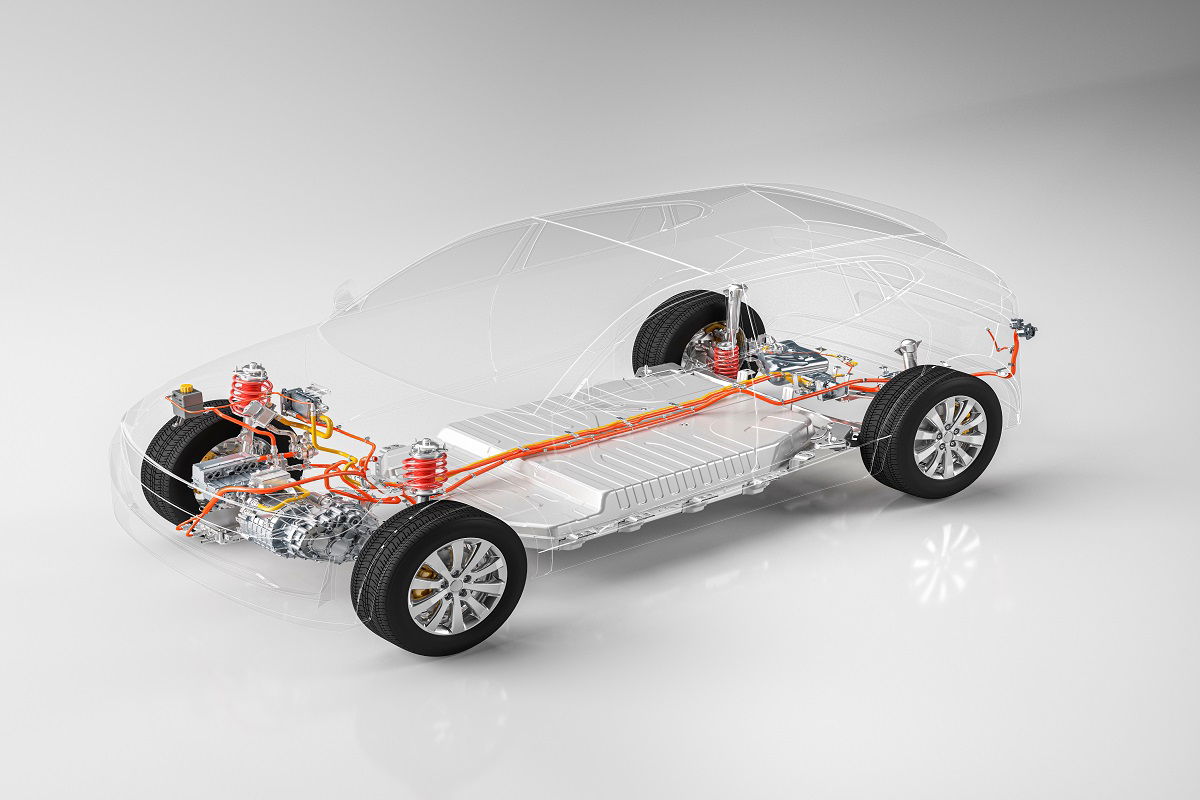
Photo credit: OLX
The working principle of an electric motor in an EV is relatively straightforward:
1. Power Source: The process begins with the electrical energy stored in the vehicle's battery pack.
2. Inverter: This energy is typically in DC form and must be converted to AC by an inverter when using AC motors. The inverter can also adjust the frequency of the AC power to control the motor's speed.
3. Electromagnetic Interaction: Once the electric current reaches the motor, it flows through coils of wire, creating a magnetic field. This field interacts with the magnets or magnetic fields already present within the motor, generating a force.
4. Rotation: The interaction between the magnetic fields creates torque, which causes the motor's rotor to turn. The rotor is connected to the vehicle's drivetrain, which ultimately turns the wheels.
5. Regenerative Braking: Many EVs also use their electric motors as generators during braking. The motor's direction of operation is reversed, so instead of using electricity to create motion, the motor uses the motion of the wheels to generate electricity, which is then fed back into the battery.
By the way, the benefits of regenerative braking are twofold. Firstly, it improves energy efficiency by recapturing energy that would otherwise be lost as heat during traditional braking systems in internal combustion engine vehicles.
This recycled energy can then be used to power the vehicle's electrical systems or assist in propulsion, reducing the overall energy consumption of the vehicle. Secondly, regenerative braking enhances the driving range of electric vehicles.
By recovering and storing energy during braking, EVs can extend their range by using the captured energy to power the vehicle under normal driving conditions. This contributes to a more sustainable and efficient driving experience, as EVs can travel longer distances on a single charge.
In Layman Terms:
Imagine the electric energy in an electric car is like the juice in a juice box. It comes from a big battery pack in the car. This energy starts as direct current (DC), but some motors need it to be alternating current (AC) to work.
So, there's a special gadget called an inverter that changes the juice from DC to AC. Yep, like a magic converter. When the converted energy reaches the motor, it flows through special coils of wire, making a magnetic field.
This magnetic field talks to the magnets inside the motor, and they start dancing together, creating a push. This push makes the motor's spinning part (called the rotor) turn around, just like how a kid’s toy car's wheels spin when you push it forward.
The rotor is connected to the car's wheels, so they start moving too. Now, here's the cool part! When you want to slow down your electric car, instead of using brakes like in a regular car, the motor becomes a generator. It turns the car's movement back into electricity, like how winding up a toy car makes it go again.
This electricity goes back into the battery to charge up for later. So, it's like a big circle of energy: from the battery to the motor, then back to the battery when you slow down. And that's how electric cars keep rolling.
Components And Operation Of Electric Motors
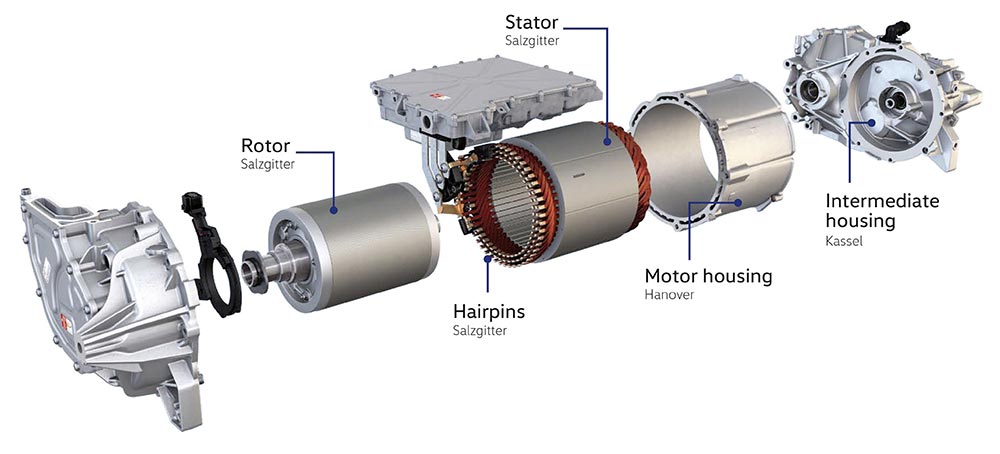
Photo credit: EV Builder's Guide
By now, you’re already familiar with the components and systems outlined in this section. Electric vehicle motors consist of several key components working together to provide efficient and reliable propulsion. They include:
1. Motor: At the heart of the electric vehicle's propulsion system, the motor converts electrical energy from the battery into mechanical energy to drive the wheels.
We've already established that EV motors come in various types, including AC induction motors, permanent magnet synchronous motors, and brushed DC motors. Each type has its own set of characteristics in terms of efficiency, power output, and torque.
2. Throttle Control: Throttle control in electric vehicles is typically managed electronically, either through a pedal position sensor or a drive-by-wire system. When the driver presses the accelerator pedal, the throttle control system adjusts the power output of the motor accordingly, controlling the vehicle's speed and acceleration.
3. Brake Systems: Electric vehicles can utilize regenerative braking systems, which allow the motor to act as a generator during deceleration.
When the driver applies the brakes or reduces speed, the motor controller reverses the motor's operation, capturing kinetic energy and converting it back into electrical energy to recharge the battery. Traditional hydraulic braking systems are still present in electric vehicles for emergency braking situations.
4. Forward/Reverse Control: Electric vehicles utilize electronic controls to switch between forward and reverse motion. Instead of a mechanical gearbox, electric vehicles typically employ a power inverter or motor controller to change the direction of rotation of the motor.
The controller dictates the rotation direction by altering the sequence and timing of electrical signals sent to the motor's coils, enabling forward and reverse motion.
Notably, the absence of traditional transmission systems also simplifies an EV’s drivetrain, reducing maintenance requirements and enhancing reliability.
Functions Of Electric Vehicle Motor Controllers
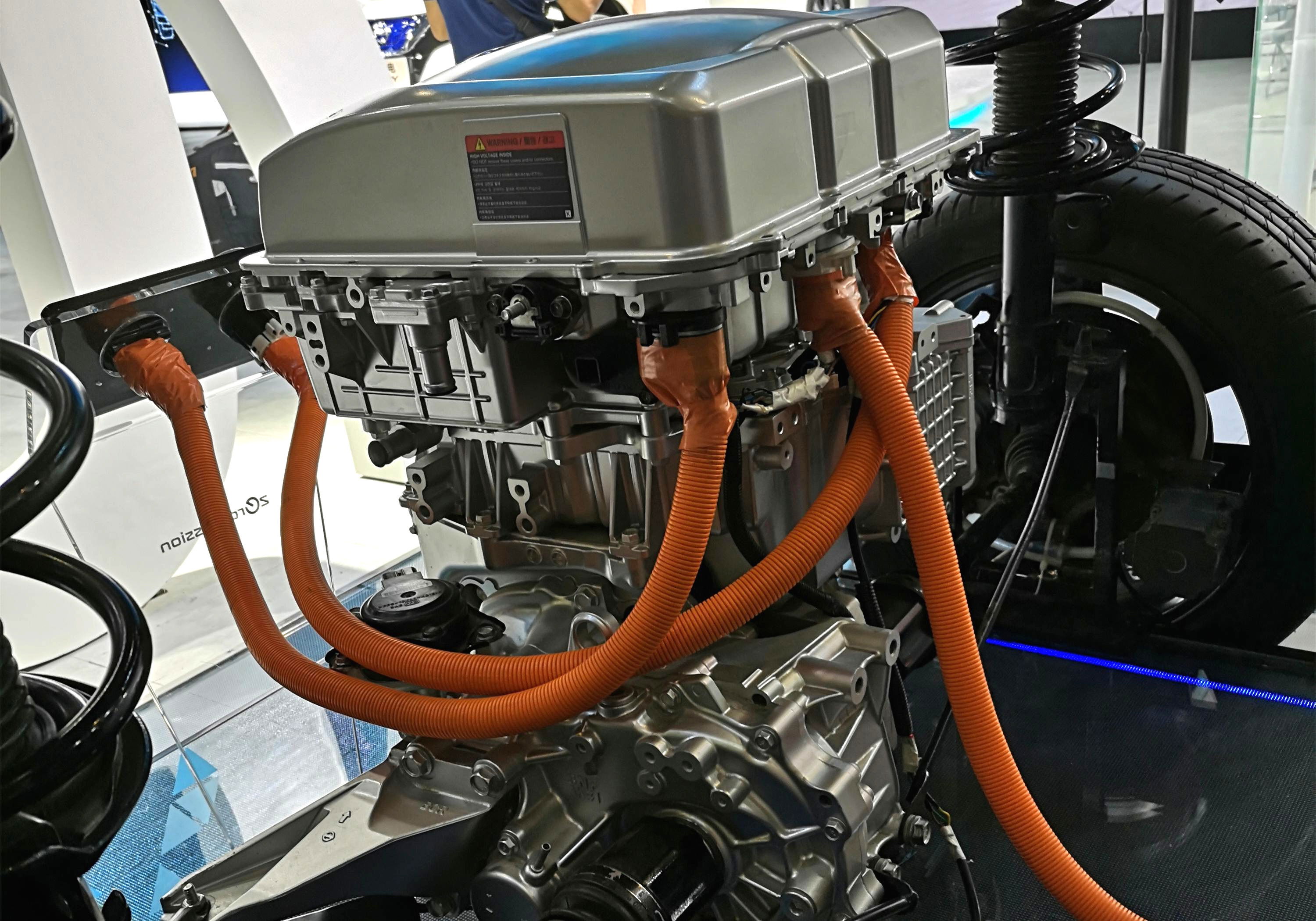
EV motor Controller housing - Photo credit: EMP Die Casting
Electric Vehicle Motor Controllers play a pivotal role in EV operation, serving as the bridge between the vehicle's battery pack and the electric motor.
Essentially, motor controllers are responsible for converting the direct current (DC) energy stored in the batteries into the alternating current (AC) required by the electric motor. At its core, a motor controller consists of power electronics and microcomputers.
The power electronics component manages the conversion of DC power from the battery into precisely controlled AC power that drives the electric motor. This process involves converting the voltage level, frequency, and waveform of the electrical signals to match the motor's requirements.
Microcomputers within the controller monitor various parameters such as motor speed, temperature, and battery status. They continuously adjust the power output to optimize performance and efficiency while ensuring the motor operates within safe limits.
This dynamic control allows for precise modulation of speed and torque, providing smooth acceleration and deceleration.
Motor controllers also facilitate regenerative braking, a key feature of many electric vehicles. During braking, the controller reverses the motor's operation, turning it into a generator to capture kinetic energy and convert it back into electrical energy, which is then stored in the battery for later use.
This regenerative braking system enhances overall efficiency and extends the vehicle's range. Furthermore, motor controllers regulate the direction of the motor, enabling forward and reverse motion.
By controlling the sequence and timing of electrical signals sent to the motor's coils, the controller dictates the rotation direction and speed.
In Layman Terms:
Imagine you have a magic box in your electric car called the Motor Controller. It's like the conductor of an orchestra, making sure everything plays in harmony. The Motor Controller connects the big battery in the car to the motor that makes the car move. It's like a bridge that helps the energy from the battery talk to the motor.
Now, inside the Motor Controller are special parts that do some magic tricks with the energy. They change the battery's energy, which is like a steady stream, into the kind of energy the motor likes. Think of it like a translator that changes one language into another.
There are also little smart computers inside the Motor Controller that keep an eye on everything. They check how fast the motor is spinning, the temperature, and how much energy is left in the battery.
These smart computers make sure everything works smoothly and safely. Lastly, the Motor Controller tells the motor which way to go. It's like a navigator in your car, giving directions to the motor on whether to move forward or backward.
So, the Motor Controller is like the EV's brain and conductor, making sure everything runs smoothly and efficiently.
Advantages Of Electric Vehicle Motors
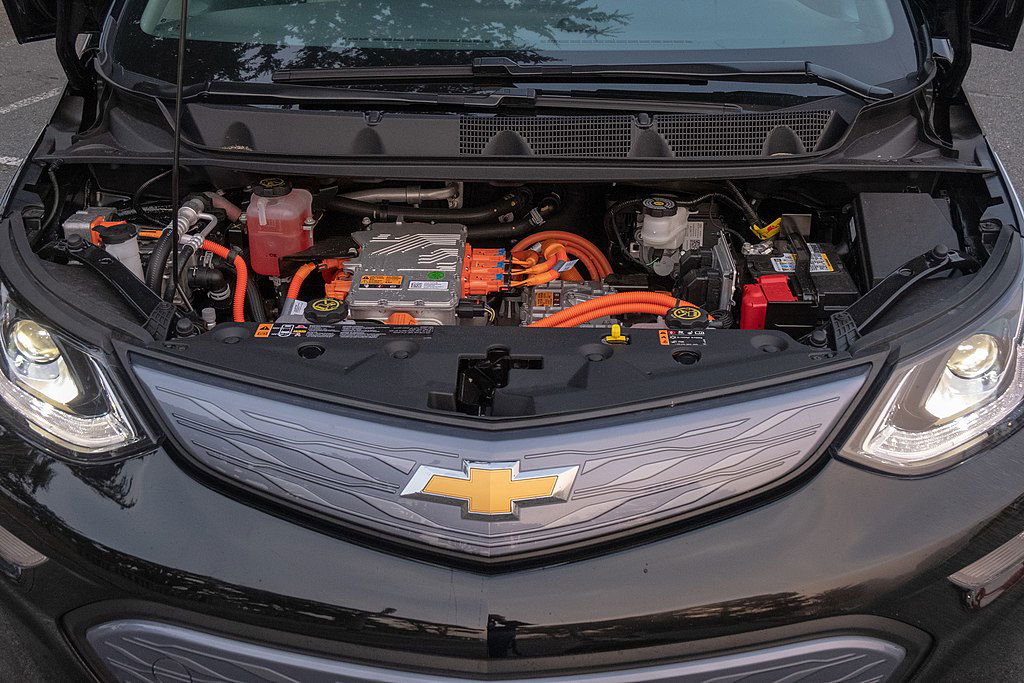
2019 Chevy Bolt EV powertrain - Photo credit: Gregory Varnum via Wikimedia
Electric motors offer numerous advantages over ICEs, including:
- Efficiency: Electric motors convert more of the electrical energy from the batteries to motion, with efficiencies typically above 90%, compared to the 20-30% efficiency of gasoline engines.
- Torque: Electric motors provide instant torque from a standstill, which means that EVs benefit from quick acceleration and responsive handling.
- Fewer Moving Parts: Electric motors have fewer moving parts than ICEs, which leads to less wear and tear and lower maintenance requirements.
- Quiet Operation: Electric motors are much quieter than ICEs, contributing to noise pollution reduction.
- Zero Tailpipe Emissions: As EVs do not burn fuel, they produce no tailpipe emissions, which is beneficial for air quality and helps reduce greenhouse gas emissions.
- Regenerative Braking: This feature not only conserves energy but also reduces brake wear, further lowering maintenance costs.
- Flexibility in Design: Without the need to accommodate bulky engines, exhaust systems, and fuel tanks, electric motors allow for more flexible vehicle design and spacious interiors.
- Energy Source Variety: Electric motors can be powered by electricity from various sources, including renewable energy, which can reduce the overall carbon footprint of driving.
e-Motor Challenges And Considerations

Mitsubishi i-MiEV high-efficiency permanent magnet synchronous motor - Photo credit: OSX via Wikimedia
While electric motors offer many advantages, there are some challenges and considerations to account for:
- Battery Cost and Weight: Although battery technology is rapidly advancing, the cost and weight of batteries remain significant factors. Large batteries are needed to provide a comparable range to ICE vehicles, which can be expensive and heavy.
- Charging Infrastructure: The convenience of EVs is partly dependent on the availability of charging infrastructure, which is still underdeveloped in many regions.
- Range Anxiety: Some consumers worry about the driving range of EVs on a single charge, although improvements in battery technology and expanding charging networks are gradually mitigating this concern.
Summarily,
Electric vehicle motors are a key technology in the shift toward sustainable transportation. They offer high efficiency, robust performance, and the potential for a lower environmental impact compared to traditional ICEs.
As technology continues to evolve, we can expect further improvements in electric motor efficiency, battery technology, and charging infrastructure, making EVs even more accessible and attractive to consumers worldwide.
For those just starting to explore the world of electric vehicles, understanding the basics of electric motors is an essential step in appreciating the benefits and potential of this transformative technology.